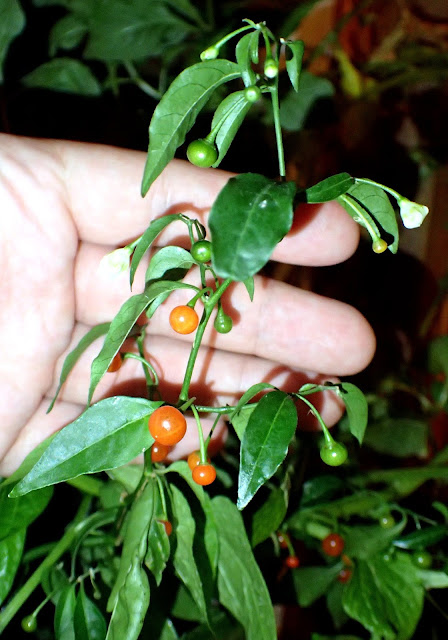Hardy Chili (Capsicum
flexuosum) it is deciduous woody shrub about
1-3m (=3-10ft) tall, which creates mildly (in case of my plants they are really
pungent) hot, very sweet in taste, small (3-7 mm = 0,12-0,28 inch), round, red
fruits and black seeds.
 |
| A branch of plant in fruits |
This very rare wild chili species is native to southern
Brazil and extremely northern adjacent part of
Argentina and eastern Paraguay. It is incredible cold and frost resistant - to
about 5-14 F degree [= (-10)-(-15) C degree] or even less in preferred
conditions. Plant very difficult to propagation from seeds. The best use GA3 (2000ppm
by 24h) + chamomile tea to soaking the seeds before sowing (or covering seeds
in a chemical fungicide instead the chamomile). The seeds germinates slowly and
irregular (sometimes after a few months since a sowing date). The best
germinates fresh seeds just removed from fleshy, never dried fruits, but dried
seeds also germinate. They should be sown surface in well drained light soil
substrate. Small seedlings are very, very susceptible for rotting. Larger
plants (above about 10-12 cm = 4-5 inch in tall) are much more resistant. Later
it is very easy to growing. It is resistant to drought and likes well drained
soil. The best for it is “cactus mix” soil if plants are grown in pots. They
should be fertilized regularly. The plant can be also easily propagated vegetative by half-wood, green cuttings (the best with a feel),
which roots easily in pots in sunny window sill (in mix of large amount of sand
and peaty soil mix – in proportion about 1:1). In literature there is
often described that this species is self-incompatible, so to obtain fruits
there are necessary at least 2 various genetically plants, but I observed that
the one single plant can sporadically create fruits without pollination by
pollen of other plant, outside and inside (also without a pollination by bees).
But to harvesting good crop there are necessary at least 2 genetically various
plants and insects. In such case plant creates very numerous fruits. The plant
has been used to crossing with other chilies. It has very valuable “frost
resistance” genes. The number of chromosomes of C. flexuosum it is the same as cultivated chili species (2n = 24).
Maybe in the future thanks its genes would be created frost hardy, large fruit
chilies? I heard that there are starting attempts of such
hybridization. I am keeping fingers crossed…
 |
| The flower |
 |
| Plant in fruits and last flowers |
There exists numerous various strains of Capsicum flexuosum - if you have avaliable seeds (or cuttings) of any of them please write to me.







I have some of these plants in junction Texas not meny around
ReplyDeleteI wanna buy a couple plants/cuts of this and lanceolatum either. Can you sell?
Deleteemail me: sender11black@gmail.com
cheers!
This comment has been removed by the author.
ReplyDeleteThanks for sharing such beautiful information with us. I hope you will share some more information about capsicum.Please keep sharing.
ReplyDeleteHealth Is A Life
I would love to buy seeds or cuttings, or live plants. Please email me at Gary.Childers@hotmail.com
ReplyDeleteyou can now buy Capsicum Ivory White Seeds- Hybrid
ReplyDeleteonline from Gardener Shopping